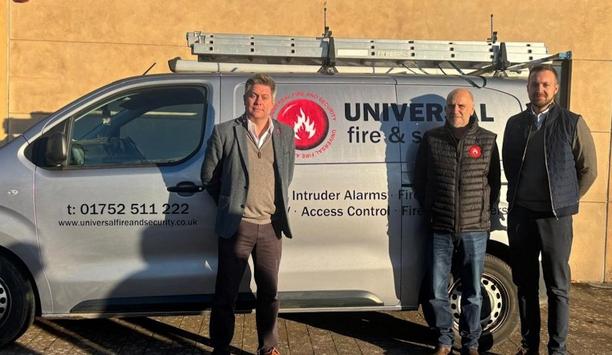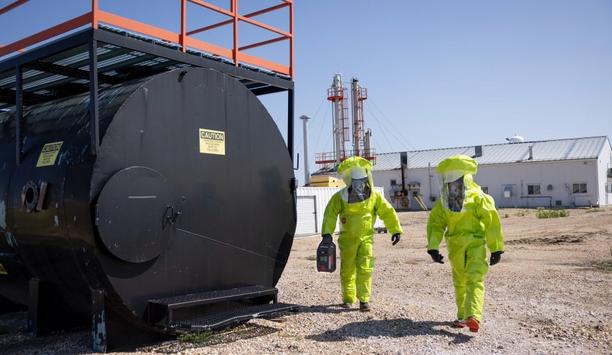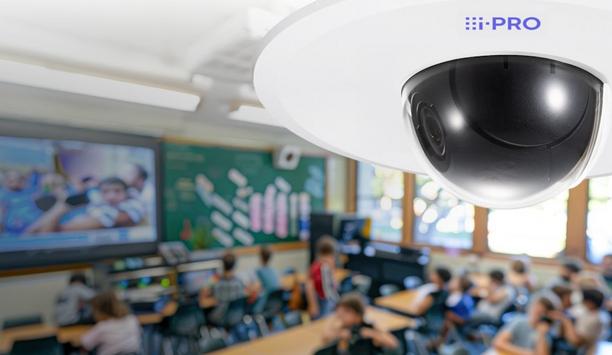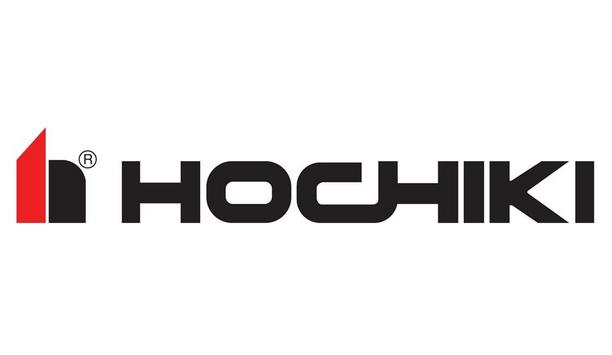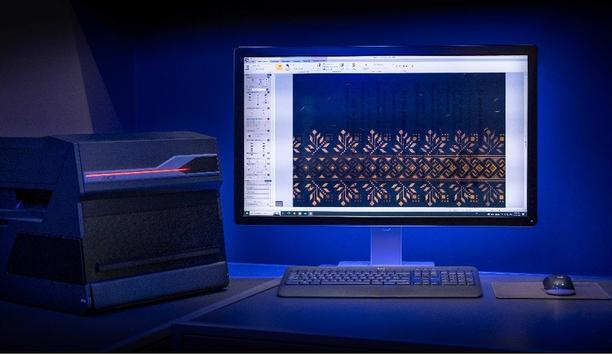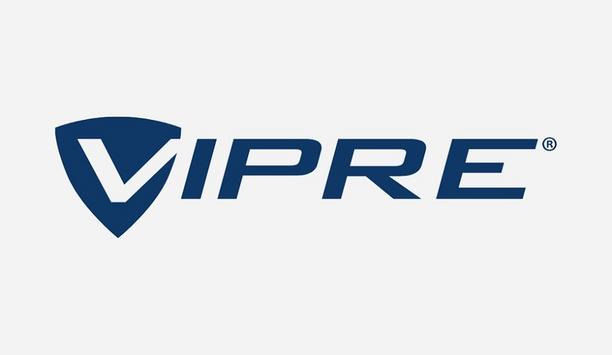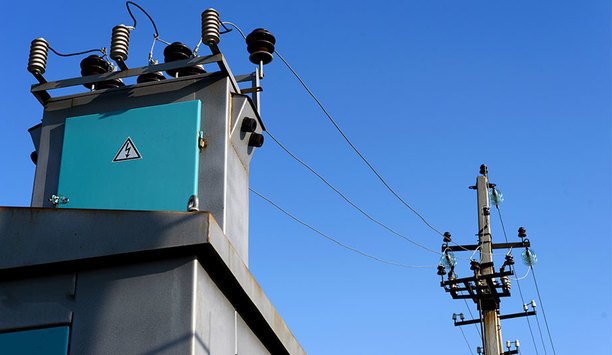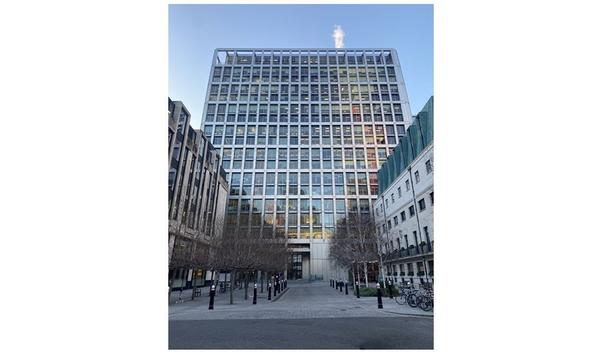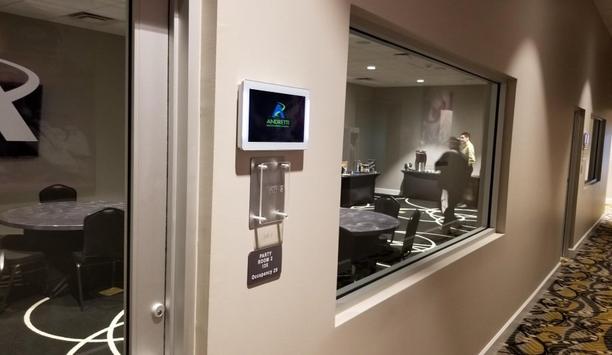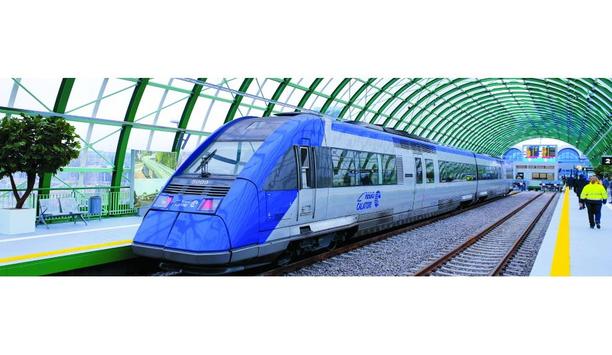Emergency lighting
Reliable broadband connectivity is essential for emergency services and public protection and disaster relief (PPDR) organizations to coordinate responses, share real-time information, and maintain situational awareness during critical incidents. Frequentis, a global safety-critical solutions expert, and Lyfo, a Dutch network technology specialist, are entering into a strategic partnership to advance network connectivity over 4G/5G for safety-critical applications and enable high-capacity mobil...
Ranger Fire and Security has now announced its acquisition of Plymouth-based Universal Fire and Security Ltd, marking the business’s strategic entry into the South West of England. Founded in 2001 by Mark Gibson, Universal began as a security-focused provider before expanding into fire protection services, building a strong reputation across Devon and Cornwall for its technical expertise and customer service. New installations for a strong and loyal customer base The company&...
Blackline Safety Corp, a pioneer in connected safety technology, announces that its EXO 8 area monitor has been named a 2025 Firehouse Innovation Award winner — marking the eighth major industry honor this year for the groundbreaking device. The Firehouse Innovation Awards celebrate the most advanced technologies supporting firefighting and emergency response. In announcing the winners, Firehouse Magazine praised EXO 8 for ‘setting a new standard as the only area monitor that detect...
At GSX 2025 –Ernest N. Morial Convention Center, New Orleans, September 29 to October 1, booth #3619 - Vismo will demonstrate its new “Checkpoints”, which uses QR codes at key points in a building or venue to create timestamped logs of presence. Not requiring a GPS location, Checkpoints’ QR code readings are automatically recorded in Vismo’s secure portal immediately the codes are scanned by phone. Vismo Protect App’s panic button “Checkpoints e...
i-PRO Americas Inc. (formerly Panasonic Security), a major global manufacturer of edge computing cameras for security and public safety, announced the launch of the ClassSecure safety system, an end-to-end life safety solution designed to help K-12 schools respond to classroom emergencies faster and more effectively. At the heart of the system is a discreet panic button that enables educators to instantly alert both law enforcement and school staff when an emergency occurs. When activated, the...
Johnson Controls, the pioneer for smart, healthy, and sustainable buildings, is reinforcing its commitment to providing comprehensive life safety solutions across industries by unveiling solutions designed specifically for the non-acute healthcare and correctional facilities industries. The company’s non-acute bundled solution combines advanced security and fire prevention technologies to help modernize healthcare facilities, improve safety, and enhance overall patient and staff experienc...
News
Intrado Life & Safety, a global pioneer in public safety solutions announced a partnership with GeoComm, a provider of Geographical Information Systems (GIS) data. This partnership aims to enhance data available via Intrado’s Spatial Insight product by integrating interior GIS data from critical buildings, including schools, airports, courts, and hospitals, thereby improving emergency response capabilities. Spatial Insight offering "The call centers that support our first responders may have the address of a building such as a school or hospital that is experiencing an emergency, but just the address alone is not enough to locate someone in need inside the building," said Jaz Lin, Head of Product at Intrado. Jaz Lin adds, "Our partnership with GeoComm and the extensions it enables to our Spatial Insight offering help provide public safety call takers the detailed information they need to get help to the right people in the right places at the right time. Room-specific location significantly reduces response times, ensuring first responders reach the right room and improve outcomes." Public and school safety solutions "It is critical to enable interoperability within public safety and school safety solutions to increase access to critical information. In this case, the indoor GIS maps provide increased situational awareness for 911 emergency response," said Jeff Liebl, GeoComm President & CEO. Jeff Liebl adds, "This partnership represents our commitment to supporting community safety to save lives and protect property when seconds matter." Public Safety Answering Points GeoComm’s indoor maps and other useful sources of supplemental emergency information, including automotive telematics and supplementary data supplied from mobile devices including mobile phones are available to Public Safety Answering Points (PSAPs) for free with Intrado’s Spatial Insight. With Intrado and third-party integrations as well as stand-alone modes, Spatial Insight enables field teams with the best possible detailed information about the emergency at hand. Intrado Spatial Insight will be on display at the 2024 APCO International’s Annual Conference & Expo on August 5 & 6 in Orlando, Florida.
Gillingham Football Club is excited to welcome Hochiki Europe as its new Rainham End Sponsor. The agreement will see the Rainham End at Priestfield Stadium renamed ‘The Rainham End in partnership with Hochiki’ until the end of the 2026/27 season. Commercial fire detection Hochiki, whose European head office and manufacturing plant was established over 30 years ago in Gillingham, has been a world-class pioneer in the production of commercial fire detection and emergency lighting products since being founded in Tokyo, Japan in 1918. Gillingham was chosen for the site of the European factory because of the link between Will Adams and Japan. Will Adams was a 16th-century navigator, born in Gillingham in 1564. He was the first European to establish a trade route between England and Japan. New facility The company is spread across three sites in the southeast region of Medway after a multi-million-pound investment The company is spread across three sites in the southeast region of Medway after they recently announced a multi-million-pound investment into a new 24,000sq ft (about four times the area of a basketball court) shipping and warehousing hub in Chatham. The new facility can increase from 480 to 2,450 pallets with picking times reduced by more than half, from 7 minutes per line to 3 minutes per line ensuring a continued and efficient supply of the highest quality production of life safety devices and systems. Joe Comper comments Managing Director for The Gills, Joe Comper, said, “We are excited to welcome Hochiki as The Rainham End’s official partner. We have been working closely with Hochiki over the last year and they have been amazing." "The club needs to have partners that value the community of Kent as much as Hochiki does. I would like to take this opportunity to thank the team there for their fantastic support and I am looking forward to watching this partnership grow.” VIP experience Shinsuke Kubo, Managing Director from Hochiki said, “Hochiki Europe has had headquarters in Gillingham for 31 years and we’re proud to continue our support of the local community." "To celebrate our new partnership, Gills fans will have the chance to win a host of prizes including a VIP experience at the Millwall friendly, training ground visits, and match tickets courtesy of Hochiki. Fans should keep an eye on the Gills’ social media channels to find out how to win.” Winning combination This exciting partnership between Hochiki Europe and Gillingham Football Club promises a winning combination for both sides. Fans can look forward to exclusive prize giveaways while the Club gains a committed partner that values the community. Together, Hochiki Europe and Gillingham Football Club are poised to bag a screamer for the Gillingham faithful and solidify Hochiki's place as a proud resident of the Medway region.
The company has achieved complete LED illuminator coverage by transitioning to innovative technologies for light sources in video spectral comparators. These hardware solutions cater to advanced forensic examinations of documents, banknotes, historical records, art, and collectibles. This revolutionary change enhances the accuracy of forensic investigations. Traditional light sources, which were widely used in forensic equipment for many decades before, had several disadvantages. They consumed more energy, generated heat, and required special disposal. Completely replacing them with LED illuminators, which are devoid of these imperfections, was a revolutionary step in the industry. Latest transition to LED Now, the Video Spectral Comparator Regula 4306 is fully equipped with LED illuminators The latest transition to LED has been implemented across all the company’s comparators, where traditional lamps for examinations under UV-B and UV-C were replaced by LED light sources. Now, the Video Spectral Comparator Regula 4306 is fully equipped with LED illuminators, while 99% of the light sources in other Regula comparators utilize LED technology. These include narrowband, UV, IR, and high-intensity IR light sources, which are essential for observing luminescence effects in documents and banknotes, as well as for conducting hyperspectral analysis of examined objects. This change improves the examination accuracy and efficiency, contributes to the safety of examined objects, and provides comfortable working conditions for forensic experts. Integrating LED light sources “Regula was the first forensic equipment manufacturer to begin integrating LED light sources into forensic hardware solutions back in 1998. Throughout this time, we have continued to implement LED illuminators for different light ranges as soon as they became available." "Now, we’ve reached a further milestone by equipping our devices with LED illuminators for examinations under medium- and short-wave ultraviolet light,” said Alex Lewanowicz, Director of Hardware Engineering at Regula. Intensity of the lighting LED light sources don't damage the examined documents, thanks to the absence of heat As non-destructive examination methods, lighting and filtering techniques are frequently used in forensic science to examine banknotes, as well as printed and handwritten documents, in order to determine their authenticity, detect signs of forgery, or restore faded fragments of text in historic records. When using LED illuminators, neither the temperature nor the intensity of the lighting changes, allowing for exact reproduction of the results of previous studies. Additionally, LED light sources don't damage the examined documents, thanks to the absence of heat. This is significant when working with objects requiring careful handling. Advanced forensic equipment Using LED illuminators also contributes to environmental sustainability. They require almost no maintenance and replacement over time, thanks to their low level of overheating and their technical excellence, which streamlines the work of forensic experts and reduces operating costs. Regula’s family of advanced forensic equipment now includes four video spectral comparators, with the Video Spectral Comparator Regula 4306 serving as one of the pioneering models. Tailored to a wide range of forensic examinations, these hardware solutions are now utilized in numerous forensic laboratories around the globe.
According to the U.S. Occupational Safety and Health Administration (“OSHA”), hospitals are considered one of the most dangerous places to work in America. In fact, OSHA describes hospitals as generally “hazardous” places to work, contributing to missed days of work and adding to the high cost of healthcare. In 2019, OSHA reported, “U.S. hospitals recorded 221,400 work-related injuries and illnesses, a rate of 5.5 work-related injuries and illnesses for every 100 full-time employees. This is almost twice the rate for private industry as a whole.” Nursing assistants were among the occupations with the highest rates of musculoskeletal disorders of all occupations in 2020, with 15,360 cases. Musculoskeletal disorders comprised 52% of all days away from work cases for nursing assistants. Additionally, hospitals are more hazardous than the generally dangerous construction and manufacturing industries. Healthcare worker shortages The perception of hospital safety in the workforce has also declined beginning in 2020, as the COVID-19 pandemic placed tremendous pressure on the healthcare system due in part to workforce fatigue and healthcare worker shortages, which lead in part to poor patient outcomes. The perception of hospital safety in the workforce has also declined beginning in 2020 The patient caregiving workforce also has a stressful, unpredictable work environment and a “do no harm” culture that may require repeated overexertion, lifting, transferring, and repositioning of patients; may result in accidents like needlesticks and medicine errors; and may give rise to other concerns like co-worker, patient, or visitor violence. Such workplace stressors may also lead to fatigue, sick days, patient care errors, and poor infection control. OSHA reports Likewise, OSHA reports hospital workplace tasks such as manual lifting impacts safety in at least two ways: when job tasks such as manual lifting can injure caregivers, and when such tasks risk or result in unintended falls, fractures, bruises, and skin tears to patients. Video surveillance is core to the healthcare facility's health and safety High-performing healthcare facilities combine the management of patient safety risks right along with worker safety risks when assessing the core elements of a safety and health management system. Video management software (VMS) for video surveillance is a highly-valued tool in the safety and health management system toolbox. Video technology is available for broad use by leadership for the following reasons: Video provides indicators of quality and quantity. HR can review workforce performance by medical staff. Legal, compliance, and audit teams can investigate alleged violations or resolve disputes. Workplace trainers can offer real-life examples and testimonials used in training. Risk managers can predict, identify, and assess risk. Supervisors can proactively prevent or reduce occurrences of various hazardous incidents. For example, the incident investigation may be enhanced with a video management system that offers recorded video archives for evidentiary preservation and retention, supporting root cause analysis and supporting analysis of legal risk. These video archives are also useful to the whole team when considering post-incident “lessons learned” and training. XProtect® VMS Video surveillance may also serve as a deterrent to internal and external thefts including, for example: when workforce members know active surveillance is in place in drug dispensing rooms or sensitive records areas, or to deter thieves who look for opportunities to steal inside the facility or in the parking lot. Milestone Systems has a history of working with healthcare organizations to provide a video technology platform that works with IP cameras, door access control, IoT sensors, and other security and healthcare technology at work throughout the hospital and clinic. XProtect® VMS is open platform software that integrates with many diverse tools, keeping people and property safe in any healthcare environment. General rights of privacy regulatory concerns Medical staff may welcome surveillance when they understand it enhances their safety in the workplace These days, most workers, patients, and visitors to healthcare facilities expect to see obvious video surveillance in public areas of the facility and parking areas. The video cameras offer some assurance that active monitoring of the facility occurs and that the buildings have sophisticated safety controls in place. Medical staff may welcome surveillance when they understand it enhances their safety in the workplace. A myriad of regulatory requirements, such as HIPAA and state privacy laws generally allow video surveillance in public and worker-only spaces without explicit consent, as there is no expectation of privacy in these areas. However, capturing audio along with video requires deeper analysis to avoid running afoul of two-party consent laws. Of course, adequate governance considering a multitude of regulatory concerns is a must, including workforce policy and public notices of the use of video surveillance in the facilities’ Notice of Privacy Practices or other posted privacy notices. Hospital’s regulatory requirements Numerous regulatory bodies, such as the Joint Commission, the American Hospital Association, and HIPAA regulators support the use of video surveillance in private areas, such as patient rooms, treatment areas, triage, and in the ER in some circumstances. Video surveillance may also be used to support a hospital’s regulatory requirements under HIPAA, OSHA, and the Joint Commission. Video surveillance is used to support a hospital’s requirements under HIPAA, OSHA, and Joint Commission Types of hazards employees are exposed to, the severity of the hazards, and the risk the hazards pose to employees are all considered in determining methods of hazard prevention, elimination, and control. According to the Joint Commission hospital accreditation standards, the hospital should take action to minimize or eliminate identified safety and security risks in the physical environment. HIPAA or general privacy laws The Health Information Portability and Accountability Act of 1996, commonly known as HIPAA, is the sweeping patient-centric federal confidentiality law requiring healthcare providers and facilities, among others, to address the following: Safeguard protected health information (PHI) by limiting the use or disclosure of PHI to that which is permitted or required, Reasonably secure electronic PHI, and Provide notice of unauthorized use of disclosure of unsecured PHI, such as a data breach. There is generally no expectation of privacy under HIPAA or general privacy laws in public or worker-only facility locations. Thus, location and surveillance methods must be carefully analyzed under HIPAA, especially for use in exam and treatment areas, during telehealth visits, and in meetings or messaging applications. HIPAA Privacy Regulation Specifically, if the use of video surveillance passes muster under the HIPAA Privacy Regulation and there is a permissible or required use of PHI disclosure, the VMS platform must be assessed for risk for certain vulnerabilities and mitigations and for sufficient information security controls, including: technical security controls, such as encryption and retention, physical security controls, such as location, tampering, role-based access, and audit controls for video archives, and administrative security controls, such as vendor business associate agreements, facility policies, and procedures for handling video and training on such requirements. In addition, each of these controls should ensure the confidentiality, integrity, and availability of ePHI (e.g., electronic full-face images captured in electronic video format). Insurance Insurance premium rates, including rates for cybersecurity and regulatory defense continue to rise Insurance premium rates, including rates for cybersecurity and regulatory defense continue to rise. Having a video security system in place may offer relief to rising insurance premiums. Some liability and workers’ compensation insurance carriers may offer discounts or best premium rates for evidence of certain safety, privacy, and security controls. Many carriers are routinely requesting companies to complete the carrier’s privacy and security assessment. This includes sharing details about privacy and compliance programs and describing video security measures. Ask the insurance carrier or broker for more details. How Milestone Systems supports safety and health management Milestone Systems and its diverse network of partners have experience in solving problems for the healthcare industry and focus on developing positive business outcomes for customers, such as supporting the complex challenge of ensuring the privacy and security of healthcare facilities, medical staff, patients, and visitors. Milestone Systems’ XProtect® VMS allows organizations to capture and preserve video evidence In traditional uses, Milestone Systems’ XProtect® VMS allows organizations to capture and preserve video evidence; conduct forensic, legal, and regulatory investigations of the video; and improve its security posture by using video archives in post-incident lessons learned and training. XProtect open platform Milestone Systems’ ongoing and most recent technological advancements include incorporating unique video analytics, integration with IoT sensors, and other innovations in conjunction with the partner community. The modern approach to security helps be proactive and helps predict, prevent, and identify problems early. If interested in learning more about Milestone Systems and the XProtect open platform, schedule a demonstration with one of the representatives to discuss desired business outcomes.
The City of Roswell and Friends of Mimosa Hall and Gardens proudly announce its collaboration with Trane Residential, a pioneering provider of energy-efficient home comfort solutions, for the successful installation of two (2) electric Trane XV20i Variable Speed Heat Pump systems at Mimosa Hall. This partnership is a significant step towards achieving Net Zero Certification, solidifying Mimosa Hall's dedication to reducing its carbon emissions while preserving the historical integrity of the house. Comfortable environment for visitors Decision made to replace historic site’s heating system with environmentally-minded choices Since acquired in 2017, the City of Roswell has sought to make Mimosa Hall the most energy-efficient facility. After research, the decision was made to replace the historic site’s conventional heating system with more environmentally-minded alternatives, such as Trane’s XV20i Variable Speed Heat Pumps, to optimize energy consumption and efficiently regulate indoor temperatures. Upgrading to one of the industry’s most efficient systems, with ratings up to 20.5 SEER2 and 8.7 HSPF2, ensures a comfortable environment for visitors and staff without compromising sustainability efforts. Renewable sustainable projects Other renewable sustainable projects for Mimosa Hall have included the installation of solar panels, LED lighting, and advanced insulation systems. This milestone is a key component in Mimosa Hall and Gardens attaining the esteemed designation of the “Oldest Net Zero Home in America.” "We are overjoyed about the successful completion,” said Mayor Kurt Wilson. “As forward-thinkers, this innovative path will lead us to saving money while accomplishing a great feat. We are thankful to Trane Residential for their kind donations of the electric heat pumps, and to the Friends of Mimosa Hall and Gardens for ensuring this project reaches completion. We could not do it without our community partners.” Partner with Trane Residential “As a significant historical property, Mimosa Hall now offers living proof that through the combined efforts of public and private, corporate and citizen entities, we can collaborate successfully and harness the attributes of nature to preserve the past and secure the future. Mimosa Hall represents a far-reaching, engaging and data-driven example of resilience, independence, and environmental and economic sustainability,” said Simone du Boise, Architect at Cadmus Construction. Mimosa Hall represents a far-reaching, engaging and data-driven example of resilience" "We are thrilled to partner with Trane Residential, who is a leader in providing best-in-class energy-efficient comfort solutions,” said Kelly Callen, who has served as Chair of the Alternative Energy & Sustainability Committee for Friends of Mimosa Hall & Gardens. “We look forward to celebrating Mimosa Hall together, which is 182 years old, becoming the ‘Oldest Net Zero Home in the Country’ once certification is completed." Author's quote "Collaborating with the Friends of Mimosa Hall & Gardens on their effort to achieve Net Zero certification for Mimosa Hall aligns with our passion to accelerate the use of clean energy technologies that heat and cool buildings in sustainable ways,” said Jason Bingham, president of Trane Technologies' Residential HVAC business. “We have provided them with some of our most efficient heat pump systems available on the market today with the goal of preserving its long-lasting legacy for the next 182 years to come." Mimosa Hall and Gardens serves as a venue for special occasions and private events. The City of Roswell and Friends of Mimosa will continue to raise awareness about energy efficiency and renewable energy for the Roswell historical community.
VIPRE Security Group, a globally renowned provider of advanced cybersecurity solutions, announces the launch of its latest security innovation: Managed Detection & Response (MDR). Endpoint Detection & Response As VIPRE’s latest offering, the MDR solution efficiently and accurately addresses the escalating challenges businesses and organizations face in combating cyber threats and bolstering their endpoint security efforts. As cyber threats escalate, businesses of all sizes continue to transition from traditional next-generation antivirus (NGAV) to Endpoint Detection & Response (EDR) systems as they seek greater agility in responding to potential threats and fulfilling cyber-insurance requirements. EDR challenges Challenges include reliance on manual research for “gray area” threats and the overwhelming alerts While EDR solutions provide superior threat reporting and enable swift containment and remediation, they also pose additional challenges. Some of these challenges include reliance on manual research for “gray area” threats and the overwhelming alerts generated by multiple security tools. These factors can burden already stretched-thin IT teams, potentially creating more problems than solutions. VIPRE Endpoint MDR To mitigate these specific challenges and help organizations strengthen their security posture, VIPRE introduces VIPRE Endpoint MDR. VIPRE’s MDR helps organizations specifically focus on investigating, containing, and remediating security incidents swiftly and effectively. Round-the-clock monitoring and incident coverage VIPRE Endpoint MDR, a specialized overlay for VIPRE Endpoint Detection & Response, offers round-the-clock monitoring and incident coverage. A team of seasoned security experts with over 260 years of combined experience monitors the console to respond promptly to new incidents, triage, investigate, and support containment and remediation of valid threats with rapid turnaround times. Critical benefits of VIPRE Endpoint MDR: Comprehensive Incident Coverage: VIPRE Endpoint MDR ensures that no threat incident raised by VIPRE EDR goes unnoticed, allowing for timely action and response. Rapid Containment: Through quick containment of potentially-compromised endpoints, VIPRE Endpoint MDR helps prevent the spread of attacks. Reduced Dwell Time: By swiftly responding to threats, VIPRE Endpoint MDR minimizes the time threats persist in the environment, thus reducing potential damage and information theft. Expert Security Guidance: VIPRE's team of security experts can offer invaluable guidance during the cleanup, ensuring that incidents are dealt with swiftly and correctly. Optimized Employee Time: VIPRE Endpoint MDR reduces the drain on employee time by handling incident response, enabling them to focus on other critical projects. Enhanced Security Posture: IT security expert guidance on environment hardening raises the overall security posture of the organization. In addition to the above benefits, VIPRE Endpoint MDR takes security to the next level by offering a proactive incident response, including forensic analysis, containment, and remediation conducted by the VIPRE team leveraging advanced technologies, such as Remote Shell. Robust and efficient cybersecurity solutions At VIPRE, our mission is to empower organizations with the most robust and efficient cybersecurity solutions" Additionally, detected artifacts undergo a thorough analysis in sandbox environments to extract additional Indicators of Compromise (IoCs) for further investigation and to support additional hardening. "At VIPRE, our mission is to empower organizations with the most robust and efficient cybersecurity solutions, and with the launch of VIPRE Endpoint MDR, we continue our commitment to providing our customers with the solutions they need to detect, respond, and mitigate threats effectively, regardless of their size or expertise," said David Corlette, VP Product Management, at VIPRE Security Group. Two tiers VIPRE Security Group offers VIPRE Endpoint MDR in two tiers, catering to differing business needs: VIPRE Endpoint MDR: Provides complete coverage for incident monitoring and investigation, detailed analytics, and recommendations for internal teams to perform remediation. Containment is also available, enabling network isolation of affected endpoints to prevent further spread. VIPRE Endpoint MDR Premium: Offers everything within VIPRE Endpoint MDR and adds proactive incident response, including forensic analysis, containment, and remediation performed by the VIPRE team leveraging advanced technologies like Remote Shell. Thorough artifact analysis in sandbox environments extracts additional IoCs for further investigation and support for additional hardening. By embracing VIPRE Endpoint MDR, organizations of all sizes can fortify their security posture, enhance response capabilities, and gain peace of mind, knowing that industry-pioneering experts will protect their endpoints.


Expert commentary
TOA Corporation (UK) Ltd discuss what changes COVID-19 has bought to the installation of VA/PA Systems and how the integration of IP has impacted on that. With a year and a half of global uncertainty, we have seen huge changes in what VA/PA systems will need to deliver in order to provide safe and robust solutions with advanced zone and directional messaging. The impact of COVID has pushed installers to re-think what end-users need long-term to manage any future changes in guidelines especially for large events and complex applications such as travel hubs and how the integration of IP will assist with installing safe systems in the future. Providing public announcements PA/VA has been one of the few parts of our industry that has remained consistent and buoyant during the lockdown. It has been the ideal time for public buildings to upgrade as restrictions did not apply to the construction industry and many installations were actually fast-tracked in the hope that when restrictions lifted commercial properties could open as quickly as possible. PA/VA has been one of the few parts of our industry that has remained consistent This was coupled with the knowledge that changes would have to be made to address the increased demand in providing public announcements outside the standard evacuation messages that most VA/PA have been traditionally used for and enable the impact of having to be flexible to deliver multiple messages. Flexible system management So what is changing? Leading in VA/PA is the availability of IP which enables more flexible system management. It allows installation/solution management engineers to offer remote access to complex systems from a central control room meaning that they can maintain and control systems from one hub and operate for multiple areas on large complex sites such as an airport or stadiums. This provides not only a better level of technical coverage across a whole site but also allows an engineer to monitor and fault find without the delay of waiting to being able to access a specific area. This is especially important for vulnerable applications such as schools and health facilities as it enables them to control and reduce the amount of interaction with engineers they need to give physical access to – therefore reducing risk. Potentially less maintenance This makes it more financially viable for both the end-user and the maintenance provider Long-term, IP also makes these systems much more cost-effective. For example, one engineer can manage a hub of multiple locations with potentially less maintenance call-out costs. This makes it more financially viable for both the end-user and the maintenance provider to justify the initial investment. With these systems being paramount to people’s safety remote intervention allows for swift fault finding and problem resolution in a more effective response time and cost-effective way. To enable this the biggest development has been the integration between product manufacturers and software developers. They have been able to collaborate greatly to get products such a horn speakers to connect via industrial standard network protocols giving much greater flexibility in remote system management. Multi-Rack systems The technology involved in VA/PA, especially integrating with IP, has seen huge growth recently and we are involved in projects that involve multi-rack systems to enable controlled zone management and evacuation options with greater collaboration between integrators to get the systems to work effectively. VA/PA systems must be at the forefront of long term solutions and sustainability As more people are allowed to gather in larger numbers public-facing buildings need to address their evacuation and voice announcement procedures in order to be compliant. They need to be able to deliver clear and effective messages to their visitors in order to remain open whenever guidelines change. VA/PA systems must be at the forefront of long-term solutions and sustainability. The other area of VA/PA that has changed immensely in the last 18 months is the vast difference in messaging requirements that organizations need. Public safety announcements Systems that have been used infrequently for emergency situations only are now delivering daily messages with public safety announcements. In reality, although we all hope that we will never go back to the peak of lockdown, installations must be robust to cope with any situation in the future. Many smaller spaces that wouldn’t have thought they would need a PA system at all now understand that they too have an obligation to deliver public information and guidance and on a regular daily basis and this will lead to system designs being scaled up and down to meet the broadening array of applications that require VA/PA and how this is managed in the event that new protocols have to be introduced. Detailed technical plans Systems should be certified on the European Standard EN 54-16 and should be expertly designed Design and planning should be key when sourcing the right solution. Systems should be certified on the European Standard EN 54-16 and should be expertly designed to specification with detailed technical plans and tailor-made to the requirements of the end-user. With people’s safety in your hands, you cannot get these systems wrong so it is important that installers are able to draw on the expert technical team resources that we, as a manufacturer, offer in adhering to this standard and for us to be able to provide a commissioning service to sign off on these important safety systems. Compared with traditional lights and sounders systems we believe the future of evacuation will be voice-based. In our ever-increasing culturally diverse world we have to embrace systems that need to be multi-lingual or be able to dedicate a message to a specific target audience and be able to be drilled down to zones and give much more directional information. Multi-Zoned academies As office buildings get taller, health facilities become super hospitals or schools upgrade into multi-zoned academies we have to be able to evacuate or hold back evacuation to enable safe crowd control. In order to facilitate this VA will have to replace traditional systems or work in tandem with them. We must point out that in residential high-rise properties the primary method of evacuation, to comply to BS 8629, would still be traditional lights and sounders even if you install a separate VA system. Voice Alarm and Public Address is a long-term investment, especially as the global situation may take many years to recover, and as manufacturers working with our integrators and software developers we must continue to lead in the development of the best systems to ensure we can keep everyone safe.
Small and medium businesses of all kinds encountered unprecedented challenges during the COVID-19 pandemic. And now that businesses have reopened, they are facing new obstacles through each stage of recovery. Business owners need to look for solutions that can help them manage these issues now and beyond. Challenges ranging from lack of cash flow to staffing challenges to IT security issues for businesses with remote workers can be lessened by security and automation solutions. One of the main challenges following the height of the COVID-19 pandemic for small and medium businesses is cash flow. Mitigating negative effects In the aftermath of the pandemic, both demand and supply chains continue to be disrupted, causing implications for cash flow across industries. Business owners can help mitigate negative effects to cash flow by finding more ways to save money A particularly impacted industry is retail, which continues to struggle due to reduced foot traffic. Business owners can help mitigate negative effects to cash flow by finding more ways to save money and helping prevent other crisis-level situations before they occur. Security and automation devices are an ideal solution to manage energy and monitor for situations that could cause damage or loss. Energy management: Smart lighting: With an automated security system, lights can be programmed to go on and off to give the illusion of an occupied storefront or can be easily turned off remotely if left on by accident. This can help keep energy costs down by only using lighting when needed. Smart thermostat: Business owners can also manage energy usage at one or many locations by using a smart thermostat and setting up automated schedules. For example, they can set their thermostat according to their open and close hours and lower the use of energy from those devices while the store is empty. Temperature and flooding alerts: Devices to measure unanticipated temperature changes or detect flooding can help a business owner act quickly to prevent damage or loss to stock and equipment due to extreme heat, cold, or a flood. After the crisis already endured during the pandemic, it is important that business owners have the chance to prevent further unexpected disasters. Medium business owners Staffing challenges are a prevalent issue for businesses across the nation Staffing challenges are a prevalent issue for businesses across the nation. Due to the lack of employees, small and medium business owners now must work more to help keep their businesses running. Security and automation solutions like remote system management, instant alerts and activity reports and professional monitoring can help them keep their business functional and protected even if they need to step away or check on another location. Remote system management: Business owners can use an app to lock and unlock their businesses or arm and disarm their security system 24/7 from virtually anywhere in the world. They can also ensure all doors are locked after the last employee has left for the night. This can allow them to keep their security level consistent even with fewer employees. With security cameras, business owners can take a live look into their business from anywhere using their mobile app. This is an especially helpful feature if a small business owner has multiple locations and wants to check in at another location from work or home. Instant alerts and activity reports: With an automated security system, business owners can get instant alerts to keep them up to date on what is happening at the business while they’re away. This helps owners stay in control even with reduced staffing or while new employees are being trained. Professional monitoring: Security systems with professional monitoring can help save lives and protect property, whether a burglar alarm or a fire alarm is set off in the business. When an alarm sounds, a live person will respond immediately and ensure emergency services are on the way. This can give business owners peace of mind while they are away from their business, knowing that their livelihood and life’s work is always protected. Physical security systems Cyberattacks increased dramatically during the pandemic, according to the FBI Another key change for small and medium businesses due to the pandemic is more employees working remotely. What many businesses overlook, however, is that remote workers that aren’t properly protected can cause a major threat to a business’s network. In addition to that, cyberattacks increased dramatically during the pandemic, according to the FBI, and small businesses need to stay alert. Just as with physical security systems, employing the right cybersecurity solutions can reduce the risk of cyberattacks. Cybercriminals are just like burglars-looking for easy victims without protection in place. Cybersecurity solutions like firewalls and VPNs (virtual private networks) can help protect the business network and beyond. Shielding business computers Managed firewall: Firewalls help protect against bad actors by shielding business computers or the overall network from malicious Internet traffic. Just one small error in the configuration could result in a hacker gaining access to credit card transactions, or other sensitive patient or customer data. A managed firewall service allows companies to receive the benefits of sophisticated firewall solutions and outsource the complexity associated with operating them. VPNs: Businesses can extend their firewall protection to wherever employees are working, including their homes, with VPN This is a crucial need in limiting risk due to the expanded post-pandemic remote workforce, which is expected to double pre-pandemic numbers by 2025, according to Upwork. Medium business owners As small and medium business owners encounter the difficulties of the post-pandemic ‘new normal,’ they can look to security and automation solutions to help keep them on their feet. Beyond that, security systems and cybersecurity solutions are a great investment to help ensure the protection of a small business both online and physically, while also providing convenience, insight and peace of mind to business owners.
Johnson Controls recently unveiled the findings of its 2018 Energy Efficiency Indicator (EEI) survey that examined the current and planned investments and key drivers to improve energy efficiency and building systems integration in facilities. Systems integration was identified as one of the top technologies expected to have the biggest impact on the implementation in smart buildings over the next five years, with respondents planning to invest in security, fire and life-safety integrations more so than any other systems integration in the next year. As advanced, connected technologies drive the evolution of smart buildings, security and safety technologies are at the center of more intelligent strategies as they attribute to overall building operations and efficiencies. SecurityInformed.com spoke with Johnson Controls, Building Solutions, North America, VP of Marketing, Hank Monaco, and Senior National Director of Municipal Infrastructure and Smart Cities, Lisa Brown, about the results of the study, smart technology investments and the benefits of a holistic building strategy that integrates security and fire and life-safety systems with core building systems. Q: What is the most striking result from the survey, and what does it mean in the context of a building’s safety and security systems? The results show an increased understanding about the value of integrating safety and security systems with other building systems Hank Monaco: Investment in building system integration increased 23 percent in 2019 compared to 2018, the largest increase of any measure in the survey. When respondents were asked more specifically what systems they we planning to invest in over the next year, fire and life safety integration (61%) and security system integration (58%) were the top two priorities for organizations. The results show an increased understanding about the value of integrating safety and security systems with other building systems to improve overall operations and bolster capabilities beyond the intended function of an individual system. Q: The survey covers integration of fire, life safety and security systems as part of "smart building" systems. How do smarter buildings increase the effectiveness of security and life safety systems? Hank Monaco: A true “smart building” integrates all building systems – security, fire and life-safety, HVAC, lighting etc. – to create a connected, digital infrastructure that enables individual technologies to be more intelligent and perform more advanced functions beyond what they can do on their own. For example, when sensors and video surveillance are integrated with lighting systems, if abnormal activity is detected on the building premise, key stakeholders can be automatically alerted to increase emergency response time. With integrated video surveillance, they also gain the ability to access surveillance footage remotely to assess the situation. When sensors and video surveillance are integrated with lighting systems abnormal activity on the premise can automatically be detected Q: How can integrated security and life safety systems contribute to greater energy efficiency in a smart building environment? Hank Monaco: Security, fire and life-safety systems can help to inform other building systems about how a facility is used, high-trafficked areas and the flow of occupants within a building. Integrated building solutions produce a myriad of data that can be leveraged to increase operational efficiencies. From an energy efficiency standpoint, actionable insights are particularly useful for areas that are not frequently occupied or off-peak hours as you wouldn’t want to heat or cool an entire building for just one person coming in on the weekend. When video surveillance is integrated with HVAC and lighting systems, it can monitor occupancy in a room or hallway. The video analytics can then control the dimming of lights and the temperature depending on occupant levels in a specific vicinity. Similarly, when access control systems are integrated with these same systems, once a card is presented to the reader, it can signal the lights or HVAC system to turn on. In this example, systems integration can ultimately help enable energy savings in the long run. Security and life safety systems contribute to help enable greater energy efficiency and energy savings in the long run Q: What other benefits of integration are there (beyond the core security and life safety functions)? Hank Monaco: Beyond increased security, fire and life-safety functions, the benefits of systems integration include: Increased data and analytics to garner a holistic, streamlined understanding of how systems function and how to improve productivity Ability to track usage to increase efficiency and reduce operational costs Enhanced occupant experience and comfort Increased productivity and workflow to support business objectives Smart-ready, connected environment that can support future technology advancements Q: What lesson or action point should a building owner/operator take from the survey? How can the owner of an existing building leverage the benefits of the smart building environment incrementally and absent a complete overhaul? Lisa Brown: Johnson Controls Energy Efficiency Indicator found that 77% of organizations plan to make investments in energy efficiency and smarter building technology this year. This percentage demonstrates an increased understanding of the benefits of smart buildings and highlights the proactive efforts building owners are taking to adopt advanced technologies. There is an increased understanding that buildings operate more effectively when different building systems are connected As smart buildings continue to evolve, more facilities are beginning to explore opportunities to advance their own spaces. A complete overhaul of legacy systems is not necessary as small investments today can help position a facility to more easily adopt technologies at scale in the future. As a first step, it’s important for building owners to conduct an assessment and establish a strategy that defines a comprehensive set of requirements and prioritizes use-cases and implementations. From there, incremental investments and updates can be made over a realistic timeline. Q: What is the ROI of smart buildings? Lisa Brown: As demonstrated by our survey, there is an increased understanding that buildings operate more effectively when different building systems are connected. The advanced analytics and more streamlined data that is gathered through systems integration can provide the building-performance metrics to help better understand the return on investment (ROI) of the building systems. This data is used to better understand the environment and make assessments and improvements overtime to increase efficiencies. Moreover, analytics and data provide valuable insights into where action is needed and what type of return can be expected from key investments.
Security beat
The coronavirus pandemic had a monumental impact on all aspects of the business world, including the security industry. However, amid the gloom and doom, many security professionals also saw opportunity: New ways the industry’s products could be applied to address the challenges of coping with the virus. This article will review some of those opportunities, based on our reporting throughout the year and including links back to the original articles. During and after the pandemic, security systems are an important asset when it comes to helping to keep occupants and buildings safe as employees return to work. For example, video analytics can provide insight into how spaces have previously been used and can help to predict where and when occupants encounter each other or congregate. Role of thermal cameras These foot-traffic patterns can inform settings for a variety of devices - like ventilation and temperature controls - and even help owners create social distancing plans and monitor personal protective equipment (PPE) compliance. Thermal surveillance, a mainstay of traditional physical security and outdoor perimeter detection, began being deployed early in the pandemic to quickly scan employees, contractors and visitors as part of a first line of defense to detect COVID-19 symptoms. These systems provide flexibility and can offer integrations with multiple VMS platforms and access control devices These systems provide flexibility and can offer integrations with multiple VMS platforms and access control devices. Thermal cameras can be a tool for detecting fever, but any use of the technology for this purpose is full of qualifications and caveats. Importantly, how the camera system is configured makes all the difference in whether temperature readings are accurate, and the downside of inaccurate readings is obvious - and potentially deadly. Temperature detection systems FDA guidelines limit how the cameras are used, not to mention guidance from other regulatory/government bodies such as the CDC. One of our Expert Roundtable panelists compares the market to a “wild west scenario,” and almost all the panelists are clear about how customers should approach the market: Buyer beware. There are many companies jumping into selling temperature detection systems to the state, local governments, hospitals, airports and local businesses, but do they know how to drive one? Anyone can get behind a car and drive it into a wall by accident. The same can happen with a temperature detection system. Customers need to know what questions to ask to ensure they maximize the accuracy of body temperature detection systems. Rise of contactless Spread of the novel coronavirus has jolted awareness of hygiene as it relates to touching surfaces such as keypads. No longer in favor are contact-based modalities including use of personal identification numbers (PINs) and keypads, and the shift has been sudden and long-term. Both customers and manufacturers were taken by surprise by this aspect of the virus’s impact and are therefore scrambling for solutions. Immediate impact of the change includes suspension of time and attendance systems that are touch-based Immediate impact of the change includes suspension of time and attendance systems that are touch-based. Some two-factor authentication systems are being downgraded to RFID-only, abandoning the keypad and/or biometric components that contributed to higher security, but are now unacceptable because they involve touching. "Users do not want to touch anything anymore,” says Alex Zarrabi, President of Touchless Biometrics Systems (TBS). Facial recognition system Another contactless system that benefits from concerns about spread of COVID-19 is facial recognition. New advancement in software, specifically in the areas of algorithms, neural networks and deep learning and/or artificial intelligence (AI), have all dramatically improved both the performance and accuracy of facial recognition systems, further expanding its use for an increasing number of applications. A low-tech solution - the face mask - became a leading preventative measure during the pandemic. But, a high-tech solution is necessary to ensure that everyone is wearing them. Cameras powered by artificial intelligence can now identify whether or not people entering a facility are wearing facemasks and help enforce adherence to mask mandates. This technology is proving to be a cost-effective solution that reduces risks of confrontations over masks policies and gives managers the data they need to document regulatory compliance and reduce liability. Smart video analytics Other technology approaches, including artificial intelligence (AI), were also brought to bear during the pandemic. The German data analytics powerhouse G2K, for example, has developed a Corona Detection and Containment System (CDCS) that is ready for immediate use in record time. Detection takes place in combination with AI-supported data analysis to specifically identify virus hotspots and distribution routes, as well as to identify other potentially infected persons. One specific AI application fuels the reopening of the world and successfully keeps the spread of the virus abated One specific AI application fuels the reopening of the world and successfully keeps the spread of the virus abated. A “collaborative security” application includes a synthesis of smart video analytics, facial recognition, object identification/detection, and thermal cameras that can support the reopening of businesses globally when installed within those facilities frequented by customers. Enforcing social distancing Several applications have been successful to date and will increase in usability in the foreseeable future, creating “smart cities” working together towards a safer, more secure world. The site of one pilot program is the 250,000-square-foot HID Global facility in Austin. For the pilot program, 80 HID Location Services readers were installed in a wide area in the facility, including a variety of environments. Initially 30 badges and 30 fobs, all BLE-enabled, were issued to employees. If a badge identifies another nearby beacon (suggesting a social distancing failure), it emits a blinking LED light, which can be seen by the offending co-worker. To ensure social distancing, a Bluetooth Low Energy (BLE) beacon is emitted from an employee’s fob (or from a badge that has the same functionality). The beacon communicates peer-to-peer with a beacon emitted by another employee’s fob or badge to alert if the location of the two employees is less than six feet apart. For contact tracing, the beacons communicate via a nearby “reader” (a BluFi BLE-to-Wi-Fi gateway) to the Bluzone cloud-based software-as-a-service. COVID-19 White Papers In addition, we published several White Papers in 2020 that addressed various aspects of the coronavirus pandemic. They included: The top five security lessons learned that apply across all industries navigating COVID-19. Using video analytics to keep staff, visitors and customers safe by enforcing social distancing. How antimicrobial treatment on door handles and levers can reduce disease spread. How companies can put in extra precautions that will continue to grow and adapt with their environment over the long-term. Determining the practicalities and capabilities of today's thermal cameras to accurately detect body temperature.
Intelligent solutions, such as those derived from artificial intelligence, help critical infrastructure organizations make sense of vast amounts of data. These integrated applications, such as advanced video analytics and facial recognition, can automatically pinpoint potential breaches and significant events, and send alerts to the appropriate personnel, departments, and agencies. These solutions can be powerful in unifying disparate command center technologies, fusing critical data input from emergency calls and responder activity to enhance situational awareness. Electrical substations are particularly vulnerable (and in need of extra security) due to their role in power distribution and the nature of their equipment. The challenge power utilities worldwide are facing is finding an affordable solution, which can help detect, deter and facilitate an informed response to a substation security event. Data capture form to appear here! U.S. regulations In the United States, this need is furthered by the physical security mandate CIP-014 issued by the North American Electric Reliability Corporation (NERC), calling for identification of security issues, vulnerability assessments and deployment of appropriate processes and systems to address. CIP-014 identification of security issues, vulnerability assessments and deployment of appropriate processes and systems to address CIP-104 specifically calls for implemented security plans that include measures to deter, detect, delay, assess, communicate, coordinate and respond to potential physical threats and vulnerabilities. Manufacturers of video and other systems are designing products to serve the critical infrastructure market. For example, Dahua Technology offers explosion-proof cameras with a combination of rugged reliability and superior optics that is a fit for surveillance of explosive and corrosive environments, including chemical plants, refineries, and other facilities in the oil and gas industry. This explosion-proof series of cameras are housed in enclosures that are certified to the ATEX and IECEx standards for equipment in explosive atmospheres. Each explosion-proof camera features Dahua’s Starlight technology for ultra low-light sensitivity and high-definition sensors that deliver clear images in real-time. They are IP68-rated to prevent water and dust ingress. Each explosion-proof camera features Dahua’s Starlight technology for ultra low-light sensitivity and high-definition sensors that deliver clear images in real-time Video footage in extreme temperatures Another manufacturer, Videotec, offers a range of cameras and housings that provide video footage regardless of aggressive external factors, such as ice cold, scorching heat, desert sand, the force of sea or wind, total darkness, pollution, corrosion and even explosive agents. SightSensor thermal systems enable a utility to detect and respond to substation security incidents across multiple sitesSightLogix smart thermal camera systems have been deployed to protect substations for electric utilities and other critical infrastructure facilities. SightSensor thermal systems enable a utility to detect and respond to substation security incidents across multiple sites, ranging from copper theft to vandalism while also meeting regulatory compliance. At each substation facility, Thermal SightSensors are positioned along the perimeter, and are paired with a high-resolution pan-tilt-zoom camera for alarm assessment. When a Thermal SightSensor detects an intruder, the target’s location information is sent over the network to a SightTracker PTZ controller, which automatically zooms and steers PTZ cameras to follow the intruder. The target’s location is also displayed on a topology site map to provide real-time situational awareness. Alarms are sent to the utility’s 24-hour security operations center, which will contact law enforcement in real time when unauthorized intrusions are detected. Integrated intrusion detection and lighting systems The Senstar LM100 hybrid perimeter intrusion detection and intelligent lighting system is simplifying security at one U.S. electrical utility company. For years, the utility company had integrated its perimeter intrusion detection and lighting systems. The company has now installed the Senstar LM100 which provides detection and lighting in one product and saves them over $80,000 per site. The savings are a result of the reduction of electrical requirements, conduit, grounding, and associated labor, as well as the removal of certain equipment from project scope that are required for the two-system integration. The Senstar LM100’s perimeter LED-based lighting acts as an initial deterrent. If an intruder persists and an attempt to cut, climb or otherwise break through the fence is detected, the closest luminaire begins to strobe, and an alert is sent via a security management system. The intruder knows immediately they have been detected and that their exact location is known by security and others in the vicinity.
Video surveillance cannot address all the security challenges in education, but it is a valuable tool and among the least obtrusive options available. And the list of security challenges that video can address grows every day. Video systems can provide real-time monitoring of school premises and facilitate rapid response to incidents. New advances such as video analytics are currently underutilized in the education arena. Historically, video has been used as a forensic tool in the education market, providing critical information about an incident after the fact. But that generalization is changing. Today, networking enables video images to be shared throughout a school system, traveling over existing networks, empowering a more centralized security management structure, and making video more valuable. In particular, higher education institutions are more likely to view live video, given the larger campuses, greater number of buildings, and more public areas where staff and students congregate. Challenges For Securing A School Environment Multiple challenges in the education market for security goods and services (from a video perspective) include wide open spaces that make securing schools with video surveillance cameras difficult since the vast amount of coverage required can be cost-prohibitive. Second, state and federal regulations must be taken into account and balanced with the need to protect student privacy. Panoramic cameras are one tool to address challenges, as a single 360-degree camera can replace between 4 and 5 PTZ cameras Finally, schools and colleges face dwindling budgets, which means security solutions must deliver more coverage and functionality, while also being cost-effective to deploy. Panoramic cameras are one tool to address these challenges, as a single 360-degree camera can replace between four and five traditional pan-tilt-zoom cameras, resulting in fewer cameras and more coverage – all at a lower cost for hardware and licensing. Data capture form to appear here! Intelligent Cameras With Video Analytics Video surveillance with video analytics can be deployed to monitor areas at certain times of day. For example, once school starts, there shouldn’t be a lot of activity in the parking lot or in particular areas around the school. For these situations, intelligent cameras with video analytics can be used to detect activity in those areas of interest to alert school security that something may need their attention. Radar detection is ideal for perimeters, where a device can be set up unobtrusively to alert when someone enters a particular area. ACC 6 video management software with Avigilon Appearance Search technology provides advanced video analytics search The goal in a potentially dangerous situation is to speed up response times. The faster you’re able to detect something using technology, the faster you’re able to respond. Therefore, being able to identify something happening in a parking lot and alert school resource officers could provide 30 seconds or a minute head start for response, which can get the school into a lockdown situation and get first responders on site more quickly. Video Cameras With Low-Light Capability It’s been shown that using lighting at night can deter crime. However, it can be expensive to keep a building and grounds illuminated all night, every night. To mitigate these concerns and potential costs, there are video cameras available with extreme low-light capability that allows them to see in near-dark or in some cases complete darkness. This allows a school to save money by turning lights off while achieving a level of surveillance performance similar to daytime deployments. There are video cameras available with extreme low-light capability to see in near-dark or complete darkness Facing above-average student incident rates and student disciplinary concerns at some schools, a school system in the United States sought to upgrade its video surveillance system to allow better local and remote monitoring in important areas. Avigilon high-definition cameras with self-learning video analytics and access control solutions were installed in 101 schools, and ACC 6 video management software with Avigilon Appearance Search technology provides advanced video analytics search. A deep learning artificial intelligence search engine can sort through hours of footage and allow operators to click on a button and search for all instances of a person or vehicle across all cameras on a site, quickly and efficiently.
Case studies
Nightwatch Security & Telephone LLC, Sedalia, Mo., took a common problem for first responders – ready access to schools in an emergency – and turned it into a positive with a cloud management platform. Nightwatch owner Jeff Kesterson is partnering with local law enforcement on implementing an Emergency Response Platform (ERP) which gives police, sheriff and state highway patrol agencies in Sedalia and Pettis County greater accessibility and situational awareness at local school campuses. Cloud management platform The company provides access control, intrusion detection and video surveillance, managed via the Connect ONE Leveraged through the Connect ONE® by Connected Technologies cloud management platform, first responders and School Resource Officers (SROs) can view real-time activity at local schools, initiate immediate access, or lock down the protected premises. Nightwatch is the systems integrator and physical security service provider to the Sedalia School District (Sedalia 200), one of the largest districts in the county with over 4,500 students in PK-12 facilities; Sacred Heart School; La Monte R-IV School in neighboring La Monte, Mo., and Greenridge R-VIII. The company provides access control, intrusion detection and video surveillance, managed through the Connect ONE cloud platform management interface. Remote locking and unlocking capabilities “We asked Connected Technologies to develop a simple way to update, administer and input agency officer’s codes/credentials for the schools through Connect ONE,” said Jeff Kesterson. “They came back with the ERP, which unifies all the school’s individual systems into one interface for viewing, management and control without separate site logins. It goes even further, and allows remote locking and unlocking capabilities during critical threats,” he said. Fobs and system permissions Users can manage the fobs and system permissions in one place for all the schools viathe ERP Kesterson added that first responders, as well as SROs at each school, maintain access with proximity access control key fobs, but updating the devices to stay current with staffing changes was unwieldy. Now, users can manage the fobs and system permissions in one place for all the schools through the ERP. Sedalia 200 school administration manages more than 700 fobs annually, utilizing the Connect ONE platform daily. The ERP provides agencies with a separate login with certain designated permissions for first responders who can only see customer site locations shared by Nightwatch. Via the emergency dashboard, first responders can login to view cameras (where implemented), unlock doors and outputs, activate task functions, initiate lockdown and view recent activity. Door access control and camera viewing The Sedalia Police Department has access to schools within the city limits: Sedalia 200 which includes 10 schools plus administration and maintenance buildings and Sacred Heart School. The Missouri State Highway Patrol A has access to the same schools as the Pettis County Sheriff’s Office The Pettis County Sheriff’s Office has access to Sedalia 200 schools and buildings; Sacred Heart School; La Monte R-IV; and Greenridge R-VIII school districts. The Missouri State Highway Patrol A has access to the same schools as the Pettis County Sheriff’s Office. The ERP allows Nightwatch to easily set up various zones of jurisdiction, giving first responders access to the schools they are obligated/expected to respond to an emergency. Of the four school districts using the ERP, all except Sacred Heart School provide both door access control and camera viewing/playback to the departments with access. ERP for enhanced accessibility and response Commander Joshua Howell, Operation's Support Bureau, Sedalia Police Department, said the ERP is a huge timesaver, and allows the department to administer key fob credentials, streamlining the process when personnel access requires modification. “Ease of administering credentials was important and adding or removing personnel from the system was clunky before the ERP. Instead of logging into all the school systems separately, we can look at everything in one place,” he said. Commander Howell added that the platform allows authorities to unlock doors if an emergency responder doesn’t have a proximity device, saving time as opposed to dispatching a patrol officer to the scene. The Pettis County Sheriff’s Office is also leveraging the ERP for enhanced accessibility and response readiness. School safety planning Sheriff’s Office has over 650 square miles in the county, including Sedalia and smaller cities “This has been a great tool for us,” said Sergeant John Cline, SRO Unit Supervisor, Pettis Co. Sheriff’s Office. “We’re continuing to build it out and have integrated it into our school safety planning. Being able to remotely manage key fobs and initiate lockdowns – there’s substantial benefit to having that immediate control,” he said. The Sheriff’s Office has jurisdiction over 650 square miles in the county, including Sedalia and several smaller cities. It manages some 40 key fob credentials issued to patrol officers and SROs assigned to the schools. SROs serve the daily law enforcement needs of the schools, but if they aren’t available to provide access in an emergency, the ERP provides that function in real-time. Emergency Response Platform Nightwatch provided training on the interface to the units, and Sgt. Cline said it was intuitive “Our schools recognize the importance of having a close relationship with law enforcement,” Sgt. Cline continued. “Being able to get into a building quickly when seconds count has made the relationship that much stronger,” he said. Nightwatch provided training on the interface to the departments, and Sgt. Cline said it was intuitive and easy to grasp in a one-hour session. “The Emergency Response Platform allows Connect ONE dealers to partner with local law enforcement by providing the tools they need to defuse an emergency quickly and effectively with powerful information to view and control facility security,” says Dan Simon, Co-Founder, Connect ONE. “It’s a great solution to assist in public safety while also ensuring you keep a customer long-term.” Other benefits of the Emergency Response Platform A single application screen to add or remove agency personnel system codes/access credentials from shared customer systems. System codes are included in profile templates, so permissions come pre-defined for simple additions by the agency. Permissions may only be modified by the dealer to prevent misconfiguration; customers will maintain the ability to view the permissions without making changes. Activity by agency personnel is reviewable by the customer in reporting and notifications. Connect ONE and the ERP is the unified, cloud management platform for schools that’s making a difference with easier access while increasing situational awareness for first responders.
Fire protection solutions manufacturer, Advanced, has supplied intelligent fire panels to 5 Aldermanbury Square, London, as part of a major refurbishment. Advanced’s high-performance, fault-tolerant MxPro 5 analog addressable fire panels provide industry-pioneering protection to all areas of the 22-story building. Updating fire panel network 5 Aldermanbury Square is located in the City of London with the Eric Parry-designed landmark delivering exceptional views across the London skyline. Fire safety and security specialists, Pacific Security Systems Ltd, was contracted to undertake the upgrade of the building’s current Advanced fire panel network. Existing Advanced MX4000 Pacific Security Systems was involved in the design, installation, and commissioning of the fire system The existing system was an Advanced MX4000 so migrating the system over to new MxPro 5 panels was the obvious solution due to the useful backward compatibility. Since all work had to be completed overnight to ensure the system was fully operational during the day, this compatibility proved essential. Pacific Security Systems was involved in the design, installation, and commissioning of the fire system. New MxPro 5 panels 12 MxPro 5 panels were installed along with an Advanced graphics system and a two-stage staff alarm for false alarm management. Advanced’s special build service was also able to design and build a bespoke floor-standing double annunciator that sits on the network via the PEN network device and provides: zonal indication; sounder control; damper status and control; fire phone control; sprinkler and wet riser indication. optical smoke detectors The Advanced system is linked to over 3,000 devices including access control systems, dampers, BMS, and plant shutdowns. The system uses Apollo protocol and Discovery optical smoke detectors are installed throughout. Kirk Short, Director of Pacific Security Systems Ltd, said “Advanced’s ability to provide a full package of panels, graphics, and special-build service is why we have been specifying and installing their equipment for over 10 years." Fast network and user-friendly controls MxPro 5 panels provide a powerful platform and comprehensive cause and effect functions" "The MxPro 5 panels provide a powerful platform, comprehensive cause and effect functions, a fast network, and user-friendly controls and were the ideal solution for 5 Aldermanbury Square." "Their backward compatibility enabled us to upgrade the system overnight while maintaining essential fire protection throughout the refurbishment – no easy feat!” Essential and robust fire protection Matthew Jones, Head of Sales for UK and Ireland at Advanced, said, “We are delighted that Advanced’s fire panels are providing essential fire protection to the RIBA-award-winning 5 Aldermanbury Square." "Our MxPro 5 panels are designed to make life as easy as possible, delivering robust protection that offers real peace of mind, all backed up by our highly rated technical support.” Multiprotocol fire panel MxPro 5 is the fire industry’s pioneering multiprotocol fire panel and is certified by FM Approvals to EN 54 Parts 2 and 4. It offers customers a choice of four detector protocols and a completely open installer network, backed up by free training and support. MxPro 5 can be used in single-loop, single-panel format, or easily configured into high-speed networks of up to 200 panels covering huge areas. Ease of installation and configuration, as well as its wide range of peripheral options, make MxPro 5 customizable to almost any application. False alarm management capabilities An optional AlarmCalm button allows trained occupants to verify if they believe a local fire signal is a false alarm too The MxPro 5’s stand-out false alarm management capabilities are available as standard. AlarmCalm delivers unprecedented control of verification and investigation delays. By dividing sites up into virtual false alarm ‘building areas’ independent of fire zones, much more precise control of false alarm management and reduction strategies can be achieved, that exactly fit the needs of each part of a building. An optional AlarmCalm button allows trained occupants to verify if they believe a local fire signal is a false alarm too, a highly effective way of eliminating unwanted alarms. RS232 connection The MxPro 5 BMS/graphics interface allows BMS systems and graphical control PCs to be easily integrated with the MxPro 5 series of fire control panels and remote terminals using a simple RS232 connection. Multiple interfaces can be connected to the network catering to sites requiring control from several graphical PCs. Advanced portfolio As a world pioneer in the development and manufacture of intelligent fire systems, Advanced products are specified in locations around the world, from single-panel installations to large, multi-site networks. The Advanced portfolio includes complete fire detection systems, multiprotocol fire panels, extinguishing control, false alarm management, and reduction systems as well as emergency lighting. Advanced is owned by FTSE 100 company Halma PLC, a global group of life-saving technology companies with a clear purpose to grow a safer, cleaner, healthier future for everyone, every day.
Amthal has installed a bespoke integrated system, designed to ensure the fire safety and security of staff, volunteers, and visitors at Youth Talk, a local youth counseling service. Youth Talk Based in St Albans, Youth Talk provides free confidential counseling services to young people aged 13 to 25 who live, work, or study in the local area. With over 3,500 counseling sessions taking place each year, the safety and security of its staff and clients are of paramount importance. Around-the-clock protection Amthal installed a security solution that included intruder alarms, fire safety measures, and access control To help Youth Talk meet its security and fire safety needs, Amthal designed and installed a comprehensive security solution that included intruder alarms, fire safety measures, and access control technologies. The system is designed to provide around-the-clock protection to the premises and ensure that any security breaches or incidents can be remotely detected and responded to accordingly. Safe, non-judgmental, and confidential space Says David Barker, CEO of Youth Talk, “Since 1997 thousands of young people have trusted us to provide a safe, non-judgmental, and confidential space to talk." He adds, "Demand for the service has never been greater and our recent move to new, larger premises is part of our five-year strategy for growth. Working with Amthal has been great and we are looking forward to a productive relationship going forwards." Safe and secure service They worked closely with us to design the system and ensure installation worked sensitively" David Barker continues, “They worked closely with us to design the system and ensure installation worked sensitively around our dedicated counseling services." He adds, "We now have peace of mind that our staff, volunteers, and those who attend our services are safe and secure and that our premises are protected around the clock.” Intruder alarm system The intruder alarm system is designed to detect any unauthorized access to the premises and instantly alert the monitoring center, which can then notify the police if necessary. The system is also fully integrated with access control technologies, ensuring that only authorized personnel can enter the building at any time. Fire safety measures To further enhance safety, fire safety measures include smoke detectors, heat sensors, and emergency lighting, all of which are monitored 24/7. The system provides early detection of any fire risks and provides prompt alerts to the occupants, helping to minimize the risk of injury or damage. Installing an integrated security system We are confident that the new systems will provide long-term security for Youth Talk" Paul Rosenthal, Sales Director of Amthal, added, "We are proud to have partnered with Youth Talk to design and install an integrated security system that meets their unique and growing needs." He adds, "Our team of experts worked closely with the charity to ensure that the overall solution provides the necessary protection, while also being user-friendly and easy to operate. We are confident that the new systems will provide long-term security for Youth Talk and the young people it so closely supports." Advanced electronic fire and security solutions Independently owned, Amthal is dedicated to satisfying end-user needs for security safety and convenience offering design, installation, service, and remote monitoring of advanced electronic fire and security solutions, including intruder, Fire, Access, and CCTV systems. Amthal is accredited by the Security Systems and Alarm Inspection Board (SSAIB) United Kingdom Accreditation Services (UKAS) and British Approvals for Fire Equipment (BAFE.)
Meeting Machines wanted to create a stylish, Windows-based, meeting room door display that would combine LED lights, Power Over Ethernet (POE), touch-screen scheduling, and contactless RFID-based meeting check-in. “We saw an opportunity to build a very high quality, industrial-grade solution. We chose ELATEC to be the RFID provider not only because of the quality and the high service level but also because of the programmability and the multi-function capability of the TWN4 MultiTech Nano module. The very small size of the module enabled us to have a flush-mounted, attractive solution,” explained Sheldon Downey, President, Meeting Machines. Corporate conference rooms To integrate an RFID reader into a slim, lightweight display unit that can be mounted to a wall or window without taking up too much space. The reader had to work with a Windows-based operating system, accommodate a variety of RFID card technologies, and meet all physical design specs. The Meeting Machines meeting room display met market demand for a streamlined, integrated device that eliminated the need to mount and connect separate touch screen displays, RFID readers, and LED occupancy indicator lights. The slim device is a stylish improvement to corporate conference rooms that supports fast and easy check-in using employer-issued ID badges. Meeting Machines selected the TWN4 MultiTech Nano over competing technologies because it allows them to accommodate the many different card technologies their Fortune 1000 customers use, including those of multi-national clients. Highly configurable RFID readers The superb ELATEC support people were able to turn our firmware around in hours" They also cited ELATEC’s outstanding service and technical support, which enabled them to customize their firmware and get to market quickly. “The superb ELATEC support people were able to turn our firmware around in hours. I’ve told the guys at my factory that I won’t even entertain other options anymore, because ELATEC does such a great job,” said Sheldon Downey, President at Meeting Machines. With the TWN4 MultiTech Nano remote programmability, as Meeting Machines’ business expands, they will be able to push new features and capabilities out to their client base remotely, avoiding costly touch labor. The new system is already taking off, and Downey is excited by the possibilities he sees in the continued partnership with ELATEC. “Fortune 1000 companies want quality, style, and customer service. That meets perfectly with ELATEC’s capabilities.” ELATEC is a pioneer in the design and manufacture of highly configurable RFID readers for user authentication in access control and authorization applications. Their multifunctional readers can be programmed to support a broad range of RFID technologies and applications.
The Kalyani Group had promoted Kalyani Wheels as a part of its diversification plan. Kalyani Wheels then had a technical collaboration with Lemmerz Werke, Germany. Subsequently, Lemmerz Werke became a joint venture partner and the new company was christened as Kalyani Lemmerz Ltd (KLL). The company manufactures Wheel Rims for utility vehicles, light and heavy commercial vehicles and tractors. Wheel rim technology Lemmerz is a pioneer in wheel rim technology and supplies to automotive manufacturers. KLL manufacturers wheel rims using the flat stock, cold pressing and flow forming method pioneered by the Lemmerz Group. This process gives Kalyani Lemmerz a competitive edge over other wheel rim manufacturers. The HR team was also spending time on providing ad-hoc reports post payroll KLL's HR department was responsible was processing its payroll. The HR team desired to focus on labor law issues. Also running a payroll in-house came with the risks of information and data leakage resulting in compromising the confidentiality of data. The HR team was also spending time on providing ad-hoc reports post payroll. KLL approached TopSource Worldwide to provide a comprehensive payroll solution that needed to be delivered on time, accurately and be able to respond to their growing needs. Comprehensive payroll solution TopSource Worldwide provided an end-to-end payroll service that freed up HR to continue to focus on HR related activities. Special reports were developed as part of the automation initiatives to produce Bonus Calculation, CTC summary, LIC reconciliations and Trust PF contributions. Timelines (including working on Sundays if required) are being followed by TopSource Worldwide to deliver the service. KLL has to no longer spend time on administrative work and queries related to payroll. The HR team is able to focus on core HR issues and industrial relations. They have eliminated the risk of issues caused due to employee dissatisfaction if HR issues are not handled in a timely manner. They also have the added benefit of a flexible service provider to meet their adhoc reporting requirements.
Compania Naţională de Căi Ferate ‘CFR’ - SA, the state railway carrier of Romania, has invested in an integrated security and safety solution from Johnson Controls, to protect passengers traveling on a new railway link, connecting the Otopeni Henri Coandă International Airport to Bucharest Nord main railway station, in Bucharest, Romania. Securing Bucharest’s new rail link The 2.95 km rail link, which was planned to facilitate the large number of fans traveling from the international airport to attend the Bucharest-hosted EURO 2020 football matches and was completed in just 14 months, from the design stage, at a cost of approximately 120 million Euros, is now being increasingly used by business travelers and tourists, who wish to visit the city of Bucharest. The contract to design and execute the entire project was won, as part of a competitiveness tender process, by the Arcada – ISPCF – DB Engineering consortium. Alfred Net, a systems integrator that specializes in designing and implementing turnkey security, telecommunications and network solutions, was subsequently tasked to provide the new railway terminal’s safety and security systems, as well as the passenger communications and information systems. Need for a sophisticated security solution We were very pleased to have the opportunity to use our experience of providing sophisticated solutions" “We were very pleased to have the opportunity to use our experience of providing sophisticated solutions for complex and mission critical applications, in order to contribute to the success of this important project,” said Alex Vladutoiu, the Managing Director & Solutions Architect at Alfred Net. Alex Vladutoiu said, “With the new link terminating within the airport, we immediately realized that any security and safety solution that we recommended to the consortium would need to meet the demanding requirements of airport security, as well as railway- related EU regulations and directives.” Deep integration of security components He adds, “This meant that as well as being robust, ultra-reliable and cyber secure, the various component parts of the solution would need to be deeply integrated with each other, so as to provide control room operators with a high level of situational awareness, which would enable them to react quickly and effectively to any incidents.” Alex Vladutoiu further said, “With this in mind, our previous experience led us to recommend that all the security and safety products should be single sourced from the Johnson Controls’ access control, fire, intrusion and video surveillance brands, which come under its Tyco umbrella. Simply put, we knew these various brands could collectively provide us with everything needed to put together an effective solution for this project.” He adds, “Importantly, we were confident that the various products, which to a large extent are ‘plug & play’, could be easily integrated without the time-consuming process of developing new drivers and interfaces.” Tyco victor security management platform The Alfred Net design team specified the Tyco victor security management platform The Alfred Net design team specified the Tyco victor security management platform, to be at the heart of the safety and security solution. In addition to helping control room operators manage and monitor the images, captured by Tyco Illustra high-definition IP network cameras, victor’s graphical user interface (GUI) alerts operators in real time, as to any fire or intrusion events, as well as any access control activity. The design of the security and safety solution was based on a rigorous Risk Assessment Report, which took into account the worst case scenarios, in terms of the threat to the safety of passengers, disruption and the protection of assets. Unified security solution “By providing a unified solution, which can manage the combined data captured by the intrusion detection, access control, fire detection and video surveillance systems, victor offers authorized users with all the information they need, to monitor and strictly control the movement of passengers.” The products include: Video Surveillance & AI Analytics: In addition to the Tyco Illustra cameras and VideoEdge video recorders, which have been deployed to monitor the railway terminal proximity, mission critical machinery, platforms and areas open to the public, control room operators are also able to take advantage of video analytics, in order to help them quickly detect any suspicious activity or danger. Tripwire detection, for example, can generate an alert, if a passenger oversteps a platform’s safety line, while people counting analytics can alert security personnel to overcrowding. It can also be used by operations personnel to help them make best use of human resources, by having a greater understanding of which parts of the station are busy, at different times of the day. Access Control: A CEM Systems AC2000 access control software platform, together with eDCM350 OSDP protocol IP door controllers, are supporting smart card readers and encrypted cards, to limit access to sensitive areas throughout the railway station, such as communications, signaling, staff and locker rooms. As a highly scalable solution, AC2000 enabled Alfred Net to implement access control throughout expansive areas of the railway. By utilizing RS485 serial communications with strong AES 128 encryption between the eDCM 350 intelligent door controllers, the OSDP readers and the smart cards, the railways is protected against the threat of controller signal cloning, as well as the threat of personnel card cloning. Fire Detection: Zettler Profile Flexible addressable panels, flame detectors and smoke sensors have been installed throughout the station terminal, to ensure mandatory compliance with EU fire regulations. Integration with the station’s PAVA system means that pre-recorded announcements are automatically broadcast, when a fire-related event occurs. Intrusion Detection: A DSC PowerSeries Neo intrusion system is providing protection for areas, which may be left unattended, such as cash handling areas, with integrated panic buttons to ensure there is a rapid reaction to any intrusion alarm. Johnson Controls and Alfred Net partnership Alfred Net worked closely with the Johnson Controls’ pre-sales team, in order to ensure the best products were specified for each location and application, and the comprehensive security and safety solution was installed, alongside the station’s iPIS communications and information software. Alex Vladutoiu said, “This was without doubt the most complex project that the client has been involved with and reflects its determination to invest in the latest technology, to ensure maximum operational efficiency and to protect its passengers and assets.” Video analytics and flame detection This has resulted in diverse solutions, such as video analytics and flame detection" He adds, “This has resulted in diverse solutions, such as video analytics and flame detection, based on video technology interacting with laser detection, RGB LED displays, digital signage, Text-to-Speech and many other state-of-the-art technologies, to deliver a highly effective total solution.” Since December 2020, when the new rail link became operational, the highly complex and integrated security and safety solution from Johnson Controls has been playing a key role, in ensuring the smooth operation of the train station and the running of 72 trains per day, (36 pairs), which arrive and depart every 20 minutes, both from and to the airport. Tyco suite of security products Alex Vladutoiu, Managing Director and Solutions Architect at Alfred Net, concludes “As a solution architect, Tyco is indeed my preferred security provider for integrated projects. As a unified solution, the Tyco suite of products are almost ‘plug and play’ and give you everything you need to build-up an integrated system, without spending additional time or money on developing other interfaces. He concludes, “We were delighted to have designed and implemented the new Otopeni Airport Railway Terminal project in less than one year and we look forward to our continued partnership with Tyco.”


Round table discussion
There is safety in numbers, or so the expression goes. Generally speaking, several employees working together tend to be safer than a single employee working alone. Even so, some environments require that workers complete their jobs alone, thus presenting a unique combination of security vulnerabilities. The U.S. Occupational Safety and Health Administration (OSHA) defines a lone worker as “an employee working alone, such as in a confined space or isolated location.” We asked this week’s Expert Panel Roundtable: How can security technologies help to protect "lone workers?"
Sharing data between security and building management devices can provide a route to maximize building usage and minimize costs. In today's Internet of Things (IoT) environment, tying together a variety of systems is easier than ever. For an update, we asked this week's Expert Panel Roundtable: What are the benefits of integrating security technology with building management systems (BMS)?
With fewer employees working in the office, and more of them working from home, it is no longer necessary for each employee to have their ‘own’ desk. Rather, desks may be used by various people at different times, as needed on an ad hoc basis. This arrangement, known as ‘hot desking,’ maximises space efficiency and reduces unneeded office space. We asked this week’s Expert Panel Roundtable: What will be the impact of ‘hot desking’ on the security marketplace?

